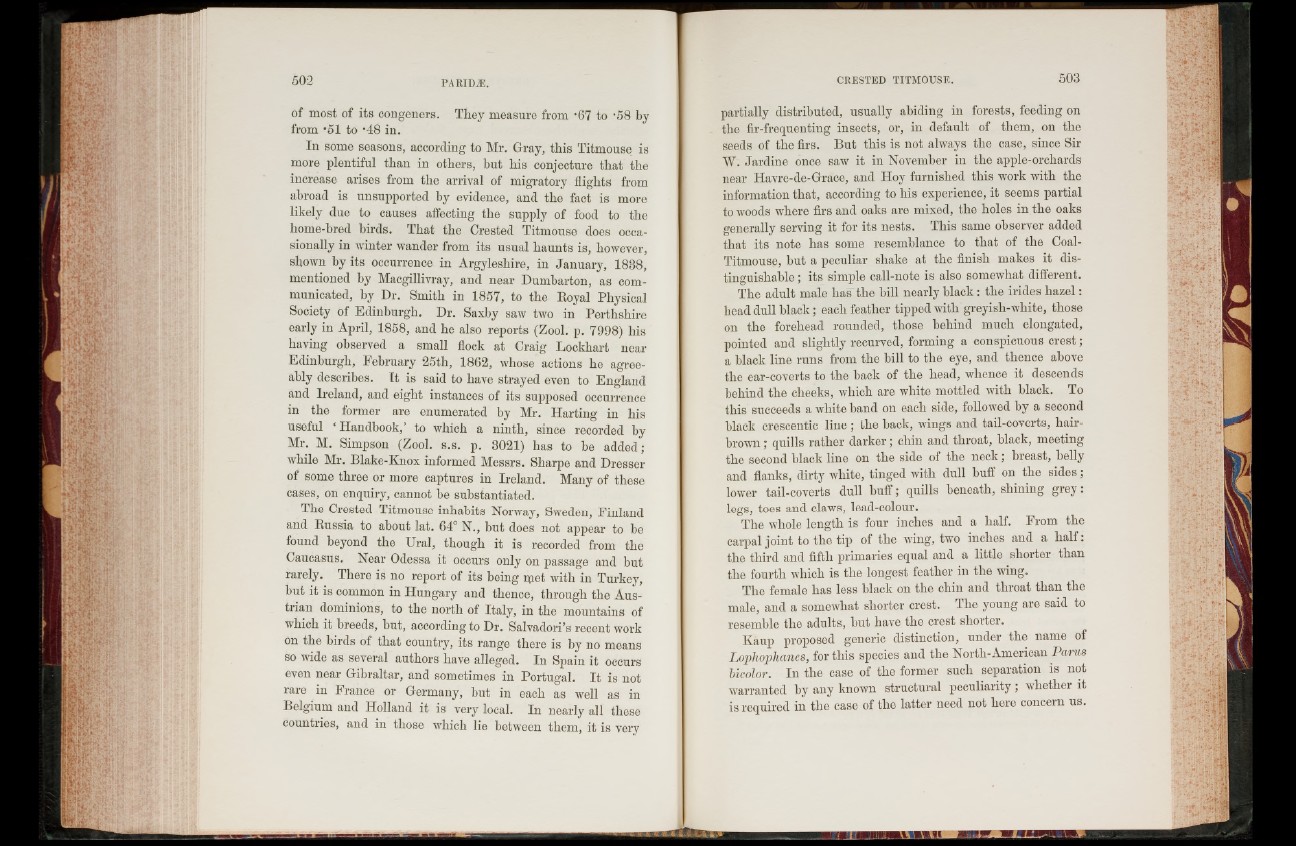
of most of its congeners. They measure from *67 to -58 by
from *51 to *48 in.
In some seasons, according to Mr. Gray, this Titmouse is
more plentiful than in others, but his conjecture that the
increase arises from the arrival of migratory flights from
abroad is unsupported by evidence, and the fact is more
likely due to causes affecting the supply of food to the
home-bred birds. That the Crested Titmouse does occasionally
in winter wander from its usual haunts is, however,
shown by its occurrence in Argyleshire, in January, 1838,
mentioned by Macgillivray, and near Dumbarton, as communicated,
by Dr. Smith in 1857, to the Royal Physical
Society of Edinburgh. Dr. Saxby saw two in Perthshire
early in April, 1858, and he also reports (Zool. p. 7998) his
having observed a small flock at Craig Lockhart near
Edinburgh, February 25tli, 1862, whose actions he agreeably
describes. It is said to have strayed even to England
and Ireland, and eight instances of its supposed occurrence
in the former are enumerated by Mr. Harting in his
useful ‘Handbook,’ to which a ninth, since recorded by
Mr. M. Simpson (Zool. s.s. p. 3021) has to be added;
while Mr. Blake-Knox informed Messrs. Sharpe and Dresser
of some three or more captures in Ireland. Many of these
cases, on enquiry, cannot be substantiated.
The Crested Titmouse inhabits Norway, Sweden, Finland
and Russia to about lat. 64° N., but does not appear to be
found beyond the Ural, though it is recorded from the
Caucasus. Near Odessa it occurs only on passage and but
rarely. There is no report of its being met with in Turkey,
but it is common in Hungary and thence, through the Austrian
dominions, to the north of Italy, in the mountains of
which it breeds, but, according to Dr. Salvadori’s recent work
on the birds of that country, its range there is by no means
so wide as several authors have alleged. In Spain it occurs
even near Gibraltar, and sometimes in Portugal. I t is not
rare in France or Germany, but in each as well as in
Belgium and Holland it is very local. In nearly all these
countries, and in those which lie between them, it is very
partially distributed, usually abiding in forests, feeding on
the fir-frequenting insects, or, in default of them, on the
seeds of the firs. But this is not always the case, since Sir
W. Jardine once saw it in November in the apple-orchards
near Havre-de-Grace, and Hoy furnished this work with the
information that, according to his experience, it seems partial
to woods where firs and oaks are mixed, the holes in the oaks
generally serving it for its nests. This same observer added
that its note has some resemblance to that of the Coal-
Titmouse, but a peculiar shake at the finish makes it distinguishable
; its simple call-note is also somewhat different.
The adult male has the bill nearly black: the irides h az el:
head dull black; each feather tipped with greyish-white, those
on the forehead rounded, those behind much elongated,
pointed and slightly recurved, forming a conspicuous cre st;
a black line runs from the bill to the eye, and thence above
the ear-coverts to the back of the head, whence it descends
behind the cheeks, which are white mottled with black. To
this succeeds a white band on each side, followed by a second
black crescentic line ; the back, wings and tail-coverts, liair-
brown ; quills rather darker; chin and throat, black, meeting
the second black line on the side of the neck; breast, belly
and flanks, dirty white, tinged with dull buff on the sides;
lower tail-coverts dull buff; quills beneath, shining grey:
legs, toes and claws, lead-colour.
The whole length is four inches and a half. From the
carpal joint to the tip of the wing, two inches and a h a lf:
the third and fifth primaries equal and a little shorter than
the fourth which is the longest feather in the wing.
The female has less black on the chin and throat than the
male, and a somewhat shorter crest. The young are said to
resemble the adults, but have the crest shoi'ter.
Kaup proposed generic distinction, under the name of
Lophophanes, for this species and the North-American Parus
bicolor. In the case of the former such separation is not
warranted by any known structural peculiarity ; whether it
is required in the case of the latter need not here concern us.